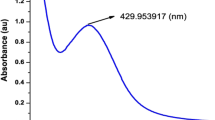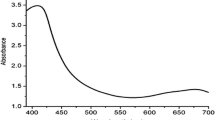Abstract
Purpose
Silver nanoparticles have been found to exhibit various bioactivities like antibacterial, anticancer, antifungal, and enzyme-mimicking properties and can be synthesized via chemical and biological methods.
Aim
This study compares the significant characteristics of chemically and biologically synthesized silver nanoparticles with sodium borohydride and Trigonella foenum-graecum leaf extract as reducing and stabilizing agents, respectively.
Methods
U.V. spectroscopy, FTIR (Fourier transform infrared) spectroscopy, DSC-TGA (Differential scanning calorimetry-Thermalgravimetric analysis), XPS (X-ray photoelectron spectrometer), and SEM (Scanning electron microscopy) were employed to characterize the nanoparticles. The antioxidant activity via FRAP assay, the nanoparticles’ cytotoxicity, and wound healing ability using MTT and scratch assay were performed.
Results
The absorption maxima were observed at 425 nm for green synthesized (GNP) and 390 nm for chemically synthesized silver nanoparticles (CNP). FTIR assignment and diffraction peaks at respective 2θ values confirmed the formation of AgNPs. The peak at 978°C in the thermogram proved the presence of silver in the biological method, and the first weight loss (42.48%) at 324.51°C for CNP exemplified the decomposition. The lower concentration of silver evidenced by XPS in GNP will benefit the toxicity-free biological effects induced by AgNPs. The presence of spherical-shaped GNP with better cell migration confirms faster wound healing with negligible toxicity compared to the multivariate-shaped CNP.
Conclusion
Although the chemically synthesized silver nanoparticle exhibited good antioxidant activity, the biogenic nanoparticle showed better antimicrobial and wound-healing potential with lesser cytotoxicity on fibroblast cells relating to the size and shape of the nanoparticles synthesized. Therefore, further studies on formulations using biogenic silver nanoparticles are worth pondering.











Similar content being viewed by others
Data Availability
The data and materials will be made available on request to the authors.
References
Kaviya S, Santhanalakshmi J, Viswanathan B. Green synthesis of silver nanoparticles using Polyalthia longifolia leaf extract along with D-sorbitol: study of antibacterial activity. J Nanotechnol. 2011;2011.
Laurent S, et al. Magnetic iron oxide nanoparticles: synthesis, stabilization, vectorization, physicochemical characterizations, and biological applications. Chem Rev. 2008;108(6):2064–110.
Crabtree JH, Burchette RJ, Siddiqi RA, Huen IT, Hadnott LL, Fishman A. The efficacy of silver-ion implanted catheters in reducing peritoneal dialysis-related infections. Perit Dial Int. 2003;23(4):368–374.
De Gaetano F, Ambrosio L, Raucci MG, Marotta A, Catauro M. Sol-gel processing of drug delivery materials and release kinetics. J Mater Sci Mater Med. 2005;16(3):261–265.
Tang S, Mao C, Liu Y, Kelly DQ, Banerjee SK. Protein-mediated nanocrystal assembly for flash memory fabrication. IEEE Trans Electron Devices. 2007;54(3):433–8.
Narayanan KB, Sakthivel N. Green synthesis of biogenic metal nanoparticles by terrestrial and aquatic phototrophic and heterotrophic eukaryotes and biocompatible agents. Adv Colloid Interface Sci. 2011;169(2):59–79.
Iravani S, Zolfaghari B. Green synthesis of silver nanoparticles using Pinus eldarica bark extract. Biomed Res Int. 2013;2013.
Mittal AK, Chisti Y, Banerjee UC. Synthesis of metallic nanoparticles using plant extracts. Biotechnol Adv. 2013;31(2):346–56.
Das RK, Gogoi N, Bora U. Green synthesis of gold nanoparticles using Nyctanthes arbortristis flower extract. Bioprocess Biosyst Eng. 2011;34(5):615–9.
Wani SA, Kumar P. Fenugreek: a review on its nutraceutical properties and utilization in various food products. J Saudi Soc Agric Sci. 2018;17(2):97–106.
Kishore K, Selvasudha N, Vasanthi HR. The multifaceted role of pectin in keratin based nanocomposite with antimicrobial and antioxidant activity. J Drug Deliv Sci Technol. 2022;75: 103661.
Luu T, Cao XT, Nguyen V, Pham NL, Nguyen HL, Nguyen CT. Simple controlling eco-friendly synthesis of silver nanoparticles at room temperature using lemon juice extract and commercial rice vinegar. J Nanotechnol. 2020;2020.
Umashankari J, Inbakandan D, Ajithkumar TT, Balasubramanian T. Mangrove plant, Rhizophora mucronata (Lamk, 1804) mediated one pot green synthesis of silver nanoparticles and its antibacterial activity against aquatic pathogens. Aquat Biosyst. 2012;8(1):1–7.
Rizwana H, Alwhibi MS, Aldarsone HA, Awad MA, Soliman DA, Bhat RS. Green synthesis, characterization, and antimicrobial activity of silver nanoparticles prepared using Trigonella foenum-graecum L. leaves grown in Saudi Arabia. Green Process Synth. 2021;10(1):421–9.
Pandey JK, et al. Silver nanoparticles synthesized by pulsed laser ablation: as a potent antibacterial agent for human enteropathogenic gram-positive and gram-negative bacterial strains. Appl Biochem Biotechnol. 2014;174(3):1021–1031.
Quintero-Quiroz C, et al. Optimization of silver nanoparticle synthesis by chemical reduction and evaluation of its antimicrobial and toxic activity. Biomater Res. 2019;23(1):1–15.
Melkamu WW, Bitew LT. Green synthesis of silver nanoparticles using Hagenia abyssinica (Bruce) JF Gmel plant leaf extract and their antibacterial and antioxidant activities. Heliyon. 2021;7(11):e08459.
Alwhibi MS, Soliman DA, Awad MA, Rizwana H, Marraiki NA. Biosynthesis of silver nanoparticles using fenugreek seed extract and evaluation of their antifungal and antibacterial activities. J Comput Theor Nanosci. 2018;15(4):1255–60.
Parang Z, Keshavarz A, Farahi S, Elahi SM, Ghoranneviss M, Parhoodeh S. Fluorescence emission spectra of silver and silver/cobalt nanoparticles. Sci Iran. 2012;19(3):943–7.
Shang M, et al. Studies on flavonoids from fenugreek (Trigonella foenumgraecum L.), Zhongguo Zhong yao za zhi= Zhongguo zhongyao zazhi= China. J Chinese Mater Medica. 1998;23(10):614–616.
Avalos-Soriano A, De la Cruz-Cordero R, Rosado JL, Garcia-Gasca T. 4-Hydroxyisoleucine from fenugreek (Trigonella foenum-graecum): effects on insulin resistance associated with obesity. Molecules. 2016;21(11):1596.
Thiruvengadam V, Bansod AV. Characterization of silver nanoparticles synthesized using chemical method and its antibacterial property. Biointerface Res Appl Chem. 2020;10:7257–7264.
Ghoshal G, Singh M. Characterization of silver nano-particles synthesized using fenugreek leave extract and its antibacterial activity. Mater Sci Energy Technol. 2022;5:22–29.
Sampaio S, Viana JC. Production of silver nanoparticles by green synthesis using artichoke (Cynara scolymus L.) aqueous extract and measurement of their electrical conductivity. Adv Nat Sci Nanosci Nanotechnol. 2018;9(4):45002.
Porcaro F, et al. Synthesis and structural characterization of silver nanoparticles stabilized with 3-mercapto-1-propansulfonate and 1-thioglucose mixed thiols for antibacterial applications. Materials (Basel).2016;9(12):1028.
Meena RK, Chouhan N. Biosynthesis of silver nanoparticles from plant (fenugreek seeds) reducing method and their optical properties. Res J Recent Sci ISSN. 2015;2277:2502.
Raja K, Saravanakumar A, Vijayakumar R. “Efficient synthesis of silver nanoparticles from Prosopis juliflora leaf extract and its antimicrobial activity using sewage”, Spectrochim. Acta Part A Mol Biomol Spectrosc. 2012;97:490–4.
Xu L, Yi-Yi W, Huang J, Chun-Yuan C, Zhen-Xing W, Xie H. Silver nanoparticles: synthesis, medical applications and biosafety. Theranostics. 2020;10(20):8996.
Cheon JY, Kim SJ, Rhee YH, Kwon OH, Park WH. Shape-dependent antimicrobial activities of silver nanoparticles. Int J Nanomedicine. 2019;14:2773.
Varghese R, Almalki MA, Ilavenil S, Rebecca J, Choi KC. Silver nanopaticles synthesized using the seed extract of Trigonella foenum-graecum L. and their antimicrobial mechanism and anticancer properties. Saudi J Biol Sci. 2019;26(1):148–54.
Hernández-Sierra JF, Galicia-Cruz O, Salinas-Acosta A, Ruíz F, Pierdant-Pérez M, Pozos-Guillén A. In vitro cytotoxicity of silver nanoparticles on human periodontal fibroblasts. J Clin Pediatr Dent. 2011;36(1):37–42.
Martinotti S, Ranzato E. Scratch wound healing assay, in Epidermal cells, Springer. 2019;225–229.
Paladini F, Pollini M. Antimicrobial silver nanoparticles for wound healing application: progress and future trends. Materials (Basel). 2019;12(16):2540.
Acknowledgements
The authors acknowledge the DBT, DHR, RGNF, and UGC fellowship, respectively from Govt. of India to execute this research work. The DST (FIST and UGC (SAP) grants to the Department of Biotechnology and the Central Instrumentational Facility of Pondicherry University for Infrastructural facilities are acknowledged.
Author information
Authors and Affiliations
Contributions
PP: investigation and methodology; NS: conceptualization, validation, formal analysis, and writing—original draft; K K: investigation, methodology, and formal analysis; SR: investigation and methodology; HRV: data curation, writing—review and editing and supervision.
Corresponding author
Ethics declarations
Ethics Approval
Not applicable.
Consent to Participate and Publish
All authors give consent to participate and publish.
Conflict of Interest
The authors declare no conflict of interests.
Additional information
Publisher's Note
Springer Nature remains neutral with regard to jurisdictional claims in published maps and institutional affiliations.
Rights and permissions
Springer Nature or its licensor (e.g. a society or other partner) holds exclusive rights to this article under a publishing agreement with the author(s) or other rightsholder(s); author self-archiving of the accepted manuscript version of this article is solely governed by the terms of such publishing agreement and applicable law.
About this article
Cite this article
Kishore, K., Prasad, P., Selvasudha, N. et al. Silver Nanoparticle Synthesized with Fenugreek Leaves Is Biologically Potent than Chemically Synthesized Nanoparticle. J Pharm Innov 18, 2029–2042 (2023). https://doi.org/10.1007/s12247-023-09769-8
Accepted:
Published:
Issue Date:
DOI: https://doi.org/10.1007/s12247-023-09769-8




